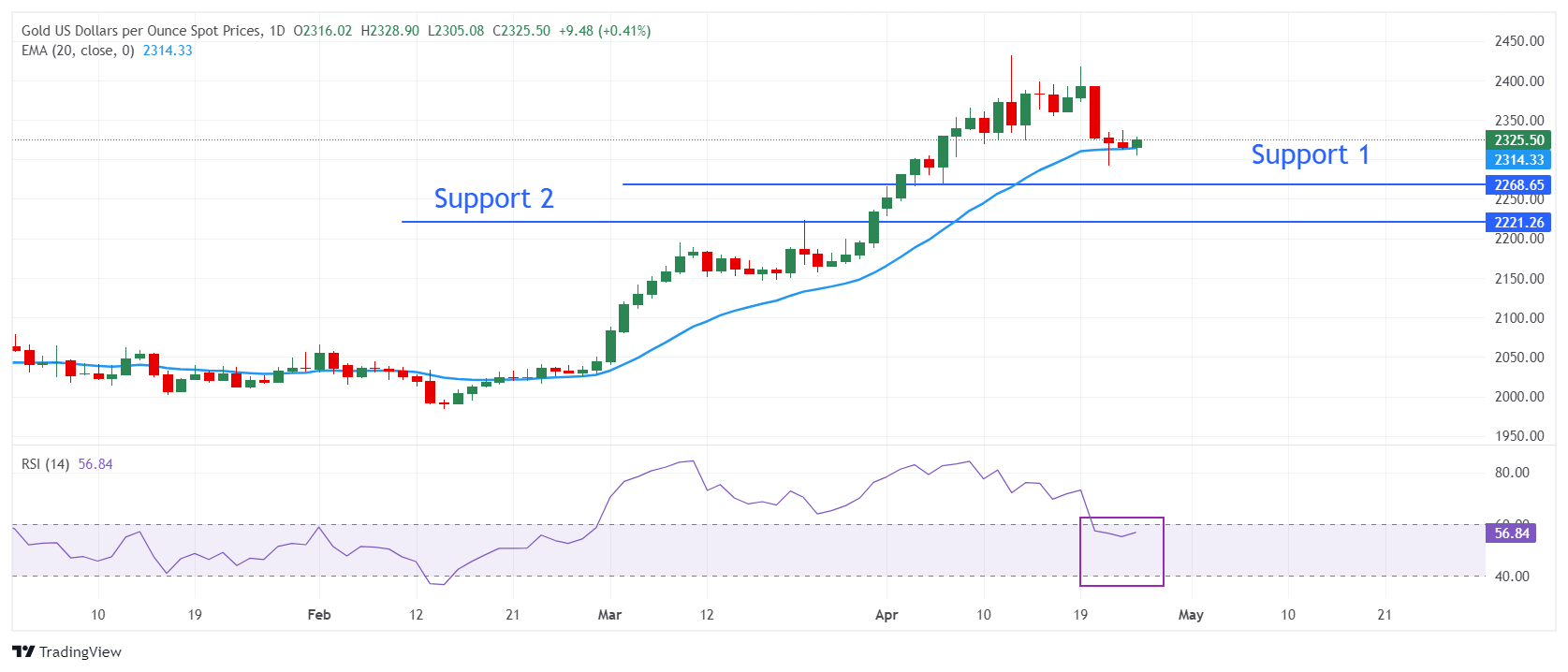Gold price rises as US Dollar edges down ahead of US GDP data
- Gold price holds above $2,300 as the US Dollar drops ahead of preliminary US Q1 GDP data.
- The Fed may maintain the “higher for longer” interest rates argument even if GDP growth remains slower than expected.
- The easing of tensions in the Middle East has improved the demand for risky assets.
Gold price (XAU/USD) remains well-supported above the crucial support of $2,300 in Thursday’s European session. The precious metal finds some bids as the US Dollar falls further amid concerns over higher interest rates by the Federal Reserve (Fed), which have impacted economic activity as shown by the S&P Global preliminary PMI report for April.
The near-term outlook for Gold remains weak as Fed policymakers see no urgency for rate cuts due to higher inflationary pressures and tight labor market conditions. Also, safe-haven demand has weakened due to waning fears of widening Middle East conflict.
Meanwhile, upcoming US macro data such as Q1 Gross Domestic Product (GDP) and the core Personal Consumption Expenditure Price Index (PCE) data for March will guide the next move in the Gold price. A significant change in the above-mentioned economic indicators will likely force traders to reassess expectations for the timing of Fed rate cuts. Currently, financial markets anticipate the first cut in September.
Daily digest market movers: Gold price aims for firm footing ahead of US data
- Gold price edges higher above $2,320 as the US Dollar extends its correction. The US Dollar faces selling pressure as weak preliminary PMI numbers for April raised concerns over the US economic outlook. The survey signalled that new business inflows in April fell for the first time in six months.
- Investors will turn their attention to the US Q1 GDP data, a key indicator of the country’s economic performance. The consensus points to a moderate 2.5% expansion, cooling from the 3.4% growth in 2023’s last quarter. Though the world’s largest economy is expected to experience a slower growth rate, growth is expected to be the strongest among the Group of Seven (G7) economies.
- Although it refers to the period from January to March, an upbeat GDP growth rate would set a positive undertone for the US economic outlook and would allow Federal Reserve policymakers to keep the monetary policy stance restrictive for a longer period. This situation would help the US Dollar, and likely weigh on Gold. On the contrary US Dollar is not expected to be hit much by slower-than-expected GDP growth as it is unlikely to scrap the speculation for the Fed to achieve the so-called soft landing, in which the central bank achieves price stability without triggering a recession.
- The week is full of volatile events as the core PCE inflation data will follow the Q1 GDP data – the Fed’s preferred inflation measure – for March, which will be published on Friday. Core PCE inflation is expected to have grown steadily by 0.3% on month, with annual figures softening to 2.6% from the 2.8% recorded in February.
- The underlying inflation data will significantly influence the Fed’s interest rate outlook ahead of its next meeting on May 1. In the May policy meeting, the Fed is widely anticipated to keep interest rates unchanged in the range of 5.25%-5.50%.
Technical Analysis: Gold price trades above $2,300

Gold price turns sideways above the round-level support of $2,300 ahead of crucial US data. The 20-day Exponential Moving Average (EMA) at $2,314 provides support to the precious metal, suggesting that the near-term upside remains intact.
On the downside, a three-week low near $2,265 and March 21 high at $2,223 will be major support zones for the Gold price.
The 14-period Relative Strength Index (RSI) falls below 60.00, suggesting that a bullish momentum is weakening. However, the upside bias is intact until the RSI sustains above 40.00.
Gold FAQs
Gold has played a key role in human’s history as it has been widely used as a store of value and medium of exchange. Currently, apart from its shine and usage for jewelry, the precious metal is widely seen as a safe-haven asset, meaning that it is considered a good investment during turbulent times. Gold is also widely seen as a hedge against inflation and against depreciating currencies as it doesn’t rely on any specific issuer or government.
Central banks are the biggest Gold holders. In their aim to support their currencies in turbulent times, central banks tend to diversify their reserves and buy Gold to improve the perceived strength of the economy and the currency. High Gold reserves can be a source of trust for a country’s solvency. Central banks added 1,136 tonnes of Gold worth around $70 billion to their reserves in 2022, according to data from the World Gold Council. This is the highest yearly purchase since records began. Central banks from emerging economies such as China, India and Turkey are quickly increasing their Gold reserves.
Gold has an inverse correlation with the US Dollar and US Treasuries, which are both major reserve and safe-haven assets. When the Dollar depreciates, Gold tends to rise, enabling investors and central banks to diversify their assets in turbulent times. Gold is also inversely correlated with risk assets. A rally in the stock market tends to weaken Gold price, while sell-offs in riskier markets tend to favor the precious metal.
The price can move due to a wide range of factors. Geopolitical instability or fears of a deep recession can quickly make Gold price escalate due to its safe-haven status. As a yield-less asset, Gold tends to rise with lower interest rates, while higher cost of money usually weighs down on the yellow metal. Still, most moves depend on how the US Dollar (USD) behaves as the asset is priced in dollars (XAU/USD). A strong Dollar tends to keep the price of Gold controlled, whereas a weaker Dollar is likely to push Gold prices up.
